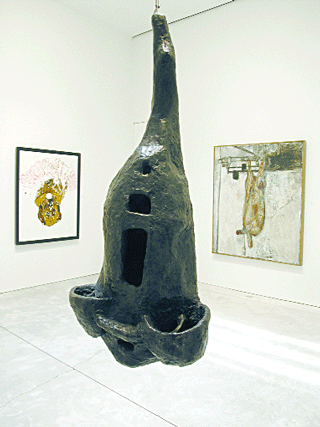The lasting influence of Chaim Soutine
This show kills. Curators Esti Dunou and Maurice Tuchman present a bracing alternative to the crop of dull summer group shows in Chelsea galleryland. Rarely attempted in New York’s McMuseum culture is the question of how does an artist’s interest and vitality pass forward and effect future generations? This part of the art story is usually passed over by museum retrospectives where the emphasis is on producing income-generating hype. Hobbled curators often can’t even make the case for their focus artist, much less are they able to enter into the kind of rich visual dialogue across generations that is currently on display at the Cheim & Read Gallery.
The almost illiterate Chaim Soutine was intent only on painting in the early years of the 20th century when he wasn’t on a bender, which he frequently was. Complicated genres and themes were beyond him and he was thrown back to the people, places, and things that surrounded him for subject matter. Thematically staggered around individual groupings, the four rooms of this exhibition tack back and forth from the everyday realities of still life and landscape, highlighting bravura paint handling and ravishing color as it has come down to us.
The beauty of brutality reverberates in the fluorescent kitchen of Alice Neel’s “Thanksgiving,” Louise Bourgeois’s gutted cast “Rabbit,” and the blunt mystery of her hanging bronze “The Quartered One.” The dead weight of Soutine’s flopped rabbits and pheasants finds a common voice in Philip Guston’s beleaguered “Lamp” and Richard Diebenkorn’s forlorn “Cup.” Joel Shapiro’s sculptural refugees from some Twomblyesque mythopoetic realm—the constricted sinew of “Untitled 2005” and the collapsed ruin of his “Untitled 2006”—are a curatorial masterstroke.
When the catalogue states “that Soutine helped de Kooning to have the fortitude to make art that disappointed taste and stood outside the fashions of the times,” you can see real evidence here. Harking back to Rembrandt, the shuddering flesh of the great bleeding “Carcass of Beef” by Soutine, is brilliantly displayed hard by De Kooning’s “Untitled XVI, 1976” a swirling creamy gray, orange piece that embodies the visceral sexiness of working wet paint. The only thing missing in this conversation is a premium Francis Bacon like the Modern’s “Painting, 1946.”
It is an experience, not to be missed, having works by Soutine, the dark Joan Mitchell, Louise Fishman, Leon Kossouth, Lucien Freud, and de Kooning all displayed together in the same room. Essentially landscapes, these dynamic, grimly powerful works of kneaded elemental paint compress and strain against each other for every breath of visual air and light. Gallery artists Fishman and Mitchell do some real chest-pounding in this place where paint tears itself free of subject matter and takes up its own life.
This is the kind of show that the small minded, great institutions no longer seem to have the ability or will to curate. In every sense of the word, bravo!
gaycitynews.com



































